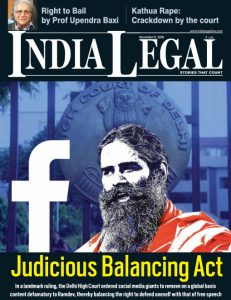
Published in India Legal dated 12th November 2019. PDF version of the article is available here:
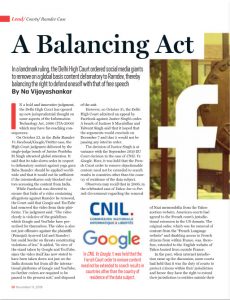 |
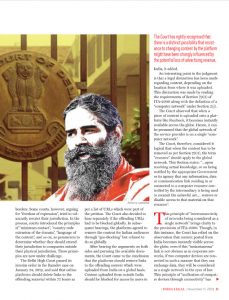 |
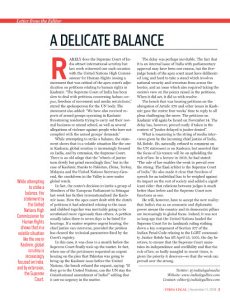 |
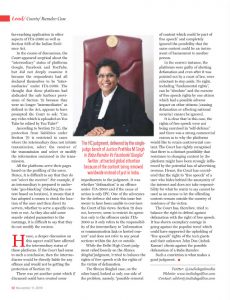 |
Naavi

Published in India Legal dated 12th November 2019. PDF version of the article is available here:
 |
 |
 |
 |
Naavi
The last few moths have seen a flurry of activity on Naavi.org related to Privacy and Data Protection. In order to bring all the articles published during this period into one list for easy reference, containing 39 articles.
It would be interesting for me to receive comments from industry experts and academicians on the different views expressed in these articles and contribute further into the knowledge base.
I invite any of the viewers to submit their views and counterpoints on the issues discussed here for publication in these columns.
Naavi
 The California Consumer Protection Act which has a bearing on the Indian IT industry processing personal data of Californian citizens is getting ready for implementation from 1st January 2019.
The California Consumer Protection Act which has a bearing on the Indian IT industry processing personal data of Californian citizens is getting ready for implementation from 1st January 2019.
On October 13, 7 amendments have been passed for the earlier Act which was passed on June 28 2018.
More importantly, a draft regulation has also been released by the Attorney General on 10th October 2019 for public comments.
Public Comments may be filed by December 6 2019.
Interested persons may study the Act as it has now emerged and also submit their comments. Naavi.org and FDPPI is collating views on the regulations and would submit its views.
Details of the Act and the regulations can be found here:
Naavi
WhatsApp has sued the Isreli Company NSO for creating and distributing the Pegasus trojan. Pegasus has been a trojan that infects mobiles (Andoriod and ios) through a mobile call even if unanswered. Once infected, it enables the hacker to silently watch the activities on the phone including reading of the messages. The virus is unremovable even with a factory reset.
It has been alleged to have been used for surveillance of Bhim Koregaon activists and their supporters in India by the Indian Government, which the Government sources predictably have denied.
This is not the first time that Israel or any other hacker group has created such tools and Governments of many countries bought the tools for their surveillance requirements. Stuxnet itself was one such example. While most of the population are not worried about Government surveillance of criminal activities, the technical possibility of a trojan that can infect mobiles through an unattended whatsapp call which can take over the mobile is alarming. If today Israel can develop Pegasus, tomorrow a criminal gang can develop a variant for similar purpose.
We already know that a virus called Xhelper has already been infecting some of the phones with properties similar to Pegasus.
While the NSO has stated that it has sold Pegasus only to some Governments and the Indian Government has itself issued a notice to WhatsApp to explain how the virus was used to snoop on Indians, WhatsApp itself has filed a complaint against NSO.
A Copy of the Complaint available here makes an interesting academic study.
The Complaint mainly alleges that WhatsApp violated the terms of use since the planting of the virus involved creation of WhatsApp accounts and making WhatsApp calls for sending the malicious codes to target phones. This also resulted in “Unauthorized Access” to WhatsApp servers which is an offence under Computer Abuse Act. It appears that WhatsApp has provided some evidence and the phone numbers used for infection which indicates the area code of Washington, USA.
The Complaint has been filed at the US district court, Northern District of California naming NSO group as the defendants. The telephone company which was a party to the activity has not been arraigned.
Charges have been brought under Computer Fraud and Aubse Act, California Comprehensive Computer Data Access and Fraud Act, Breach of Contract and Tresspass to Chattels.
Relief sought includes permanent injunction besides damages.
As regards the allegation that Indian Government has used Pegasus for snooping on some activists, it is a Canada based organization called Citizen’s Lab which has released a report. The Citizen Lab is an interdisciplinary laboratory based at the Munk School of Global Affairs & Public Policy, University of Toronto, focusing on research, development, and high-level strategic policy and legal engagement at the intersection of information and communication technologies, human rights, and global security.
According to Citizenlab after the report from the Lab in May 2019, WhatsApp fixed the vulnerability. Hence the current versions of WhatsApp may not be vulnerable to this attack.
Behind this Pegasus incident lies the discussion on ethics and security. While criminals continue to make use of all the tools of crime available in the deep web to create havoc on the organized society, when the Governments try to use similar counter Cyber crime strategies, the human rights activists start complaining.
Should Human Rights be used to defend the rights of criminals? is itself a question that needs to be answered by Courts. It is not uncommon in India that a large part of the time and energy of Supreme Court is spent in hearing cases of these “Human Right Activists” who specialize in defending the criminals by invoking the human right principles. Most of the times, the beneficiaries are the inhuman terrorists and criminals.
It is time for the Courts to draw a line on who can invoke “Human right” protection before trying to adjudicate on the ethics of Governments using tools such as Pegasus as”Tools of War”. Just as weapon manufacturers need to restrict the sale of military grade weapons only to sovereign Governments, any agency developing such tools should be considered responsible to ensure that it does not fall into wrong hands.
Perhaps the Court case in USA will determine whether NSO is a “Cyber Weapon Manufacturing Company” that deals with sovereign Governments only or tries to commercialize its weapons by selling it over to criminals and terrorists.
Naavi
 The decision of the Delhi High Court in the Baba Ramdev Vs Face Book/Twitter/Google case ordering global take down of defamatory content is likely to turn out to be a landmark judgement. Though the final word on the issue will be written by the Supreme Court when it hears the appeal, the Supreme Court has been provided with a powerful challenge if it desires to maintain judicial comity with international Courts.
The decision of the Delhi High Court in the Baba Ramdev Vs Face Book/Twitter/Google case ordering global take down of defamatory content is likely to turn out to be a landmark judgement. Though the final word on the issue will be written by the Supreme Court when it hears the appeal, the Supreme Court has been provided with a powerful challenge if it desires to maintain judicial comity with international Courts.
Very recently, in the GDPR case of CNIL Vs Google, (2019), the EU Court of Justice had reversed an earlier ruling for global takedown and ruled in favour of Google. In this case it was held that while exercising the “Right to Forget” of a French Data Subject, it is sufficient if the data is removed from the French site of Google Search and it is not necessary to remove it from other search engines. The Court in this instance held that each country search engines are different data groups and are meant for different audiences.
Long time back, the US courts also had come to similar conclusions in the Yahoo-Nazi memorabilia case.(2006) In this case, the US Courts implied that a website with a country code extension of say .fr should be considered as a site meant for France. If the language of the website was French, it was clear that the target audience are French people where ever they are located.
In these cases as well as the earlier cases, the Courts determined the jurisdiction based on the “Intentions” of the content provider using “Interactive nature” of the websites, “Maintenance of contact address in a jurisdiction” , “Offering of goods and services to the people of a jurisdiction”, etc as parameters to determine the application of extra territorial jurisdiction.
However, in the case of Dow Jones Vs Gutnick (2002) the Australian High Court held that “An Australian Citizen could maintain a defamation suit in a local Australian Court for allegedly libelous statements published in a website in USA”. It was held that “Jurisdiction was proper in the place in which the article was downloaded and read and the harm caused not where the server is located or where the publisher’s principal place of business is located”.
The Dow Jones Vs Gutnick established that jurisdiction to determine the defamation and go on trial exists in the place where the harm is felt by the victim.
This has become a standard rule today and has also been adopted in the Baba Ramdev case. Hence all defendants have not opposed the trial and have in fact even agreed to their status as “Intermediary” under Indian law and also further agreed to implement the directions to a certain extent.
Enforcement Jurisdiction outside India
What the Delhi High Court has now embarked upon is the jurisdiction to force “Enforcement Jurisdiction” outside the territory of the victim/forum.
In the appeal, the Supreme Court may have no option but to uphold the judicial jurisdiction to try the case and provide relief to the victim of defamation from a foreign company, because the defendants have admitted their responsibility under Section 79(3) of ITA 2000 at least to the extent of exposure of the objectionable content to the Indian audience through “Geo Blocking”.
The point of contention however is the decision of the High Court ordering the global take down based on its interpretation that all the servers of the defendant companies are networked to share information and hence should be considered as a “Unified Computer Network System”. Under this consideration, “Removal of Content” is not complete unless it is removed in all places where it is stored and is accessible.
The Court has made a distinction only on “Data Uploaded from India” and “Data uploaded from outside India”. As regards data uploaded from India, the Court has ordered the global take down and as regards data uploaded from outside India, the Court has ordered “Blocking access”.
This argument of determining the enforcement jurisdiction based on the place from which the content was uploaded appears to be a new thought and could come in for deeper analysis in the Supreme Court.
The second point which is likely to be contested in the Supreme Court is whether Section 79 is applicable for offences where the cause of action is not ITA 2000 but other statutes like IPC.
It is our opinion that Section 79 does not restrict itself to offences within ITA 2000 but this could be argued.
Another point which the Court could have missed is that ITA 2000 under Section 13 has given a clear indication to determine the place from which a message has been sent as the “Place of usual residence”. Hence the applicability of ITA 2000 in respect of “Message Uploaded” depends on the usual place of residence of the uploader.
If however the “uploader” is anonymous, then the system from which the uploading has taken place may become relevant. It is open to the system owner to provide the identity of the uploader and establish with evidence that the person has a place of residence outside India and hence the upload location has to be determined accordingly. If the platform owner fails to establish the identity of the uploader, then the responsibility should rest with the owner of the system.
The “Attribution” under section 11 is clear that the responsibility for any computer which works automatically is attributed to the person who caused it to behave so…which is the platform owner. This “attribution” aspect is relevant for platforms who may claim that the system is automatic, they donot interfere in the publication etc.
Since all platforms have admitted that they are “Intermediaries” and sought the protection under Section 79 claiming “Due Diligence”, the fact whether they are really intermediaries or not did not figure in the High Court judgment. It is possible that this may not come for discussion even in the Supreme Court.
Since every platform analyses the profile of the users and determines what page has to be served to them or at least recommended to them, it is impossible to consider that any of these entities namely Face Book or Twitter or Google are actually entitled to the safe harbor provision of Section 79 which requires that these entities shall not
a) Initiate the transmission
b) select the receiver of the transmission and
c) Select or modify the information contained in the transmission.
All of them may fail the test of the third condition above which is mandatory for invoking Section 79.
If these platforms are not considered eligible for Section 79 protection, then shall be guilty of “Defamation” irrespective of whether they remove the content now or not.In the Duffy Vs Google, the Australian Supreme Court made the following interesting observations.
“..the concept of “passive medium” was apt to mislead because the nature of electronic media is that it is pre-programmed to fulfill a purpose….”
“Google participated in the publication of the paragraphs about Dr Duffy produced by its search engine because it intended its search engine to do what it programmed it to do”
“Google’s search results are published when a person making a search sees them on the screen … It is Google which designs the programme which authors the words of the snippet paragraph. Google’s conduct is the substantial cause of the display of the search result on the screen”
“Google was liable for the republication of the Ripoff Report pages to which it provided hyperlinks. This was because Google’s facilitation of the reading of these pages was both substantial and proximate”
If a similar view is taken in India, it would become irrelevant whether the Companies agree to remove the content or not. They will be directly liable to pay compensation to Baba Ramdev.
Probably Mr Ramdev’s counsel cannot raise this issue at the appeal stage but another third party intervener may raise this issue and contend that these platforms Face Book, Twitter and Google do not satisfy the requirements of Section 79 and hence should not be provided the protection under the section. In that case, the argument on removal of the content becomes secondary.
How Does the Court enforce its decision?
It is all fine to say that ITA 2000/8 has extra territorial jurisdiction under Section 75 and the Court has also recognized the personal jurisdiction based on the Victim’s right to invoke the Indian Courts etc.
Now that the Court has passed the order for removal of content, the next question that would arise is what would the victim do if the respondents don’t honour the directions of the Court.
It is possible that the Supreme Court may be obliging and grant a stay. If not, it is most likely that these platforms will do nothing to implement the directions of the High Court and will contend that the matter is sub-judice.
The High Court order therefore failed to recognize the need to impose a penalty if the respondents don’t follow the orders of the Court.
Such a direction was provided in the Yahoo -Nazi Memorabilia case by a French Court which ordered payment of a fine for every day of delay in implementing the content removal directions.
If the Court had ordered similar per-diem penalty and also indicated that failure to make the payment would lead to other consequences such as blocking the service in India, then the order would have had teeth.
Now this will be another order which is appreciated by academicians but has no immediate utility for the victim. We hope that when the Supreme Court admits the appeal, it directs the appellants to agree to implement the High Court order forthwith or agree to pay some compensation for any delay before the appeal is admitted.
(This is for academic debate. Comments and counter views are welcome. I invite some of my students to take up a deeper analysis)
Naavi
Reference Articles
Baba Ramdev Vs FaceBook-High Court judgement
Dow Jones Vs Gutnick-judgement
Dow Jones Vs Gutnick..an analysis
Early Bird Pricing of Rs 6000/- for the Course is set to end on 3rd November 2019.
Watch out for more details on Cyber Law College